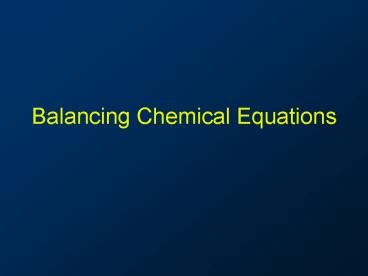Balancing Chemical Equations PowerPoint PPT Presentation
1 / 24
Title: Balancing Chemical Equations
1
Balancing Chemical Equations
2
Balanced Equation
- Atoms can not be created or destroyed
- All atoms we start with we must end up with
- A balanced equation has the same number of atoms
of each element on both sides of the equation.
3
- C O2 ? CO2
- This equation is already balanced
- But what if it isnt already?
4
- C O2 ? CO
- We need one more oxygen in the products.
- Cant change the formula, because it describes
what is.
5
- The other oxygen must be used to make another CO
- But where does the other C come from?
6
- Must have started with two Cs
- 2 C O2 ? 2 CO
7
Rules for Balancing
- Write the correct formulas for all the reactants
and products - Count the number of atoms of each type appearing
on both sides. - Balance the elements one at a time by adding
coefficients (the numbers in front) - 2 C O2 ? 2 CO
- Check to see if it is balanced
8
Never
- Never change a subscript to balance an equation
C O2 ? CO2 - If you change the formula you are describing a
different reaction. - H2O is a different compound than H2O2
- Never put a coefficient in the middle of a
formula - 2 NaCl is ok Na2Cl is not.
9
Example
- H2 O2 ? H2O
- Make a table to keep track of atoms
10
Example
- H2 O2 ? H2O
Need twice as much O in the product
11
Example
H2 O2 ? 2H2O
Changes the O
12
Example
H2 O2 ? 2H2O
2
Also changes the H
13
Example
H2 O2 ? 2H2O
4
2
Now we need twice as much H in the reactant
14
Example
2H2 O2 ? 2H2O
4
2
Recount to check
15
Example
2H2 O2 ? 2H2O
Your answer
4
4
2
Recount to check
16
Types of Reactions
- Millions of reactions
- Too many to remember
- They fall into several categories
- We will focus on Double Replacement in todays lab
17
Double Replacement
- Two things replace each other
- Reactants two ionic compounds or acids.
- Usually in aqueous solution
- NaOH FeCl3 ?
- The positive ions change place
- NaOH FeCl3 ? Fe3OH- Na1Cl-1
- NaOH FeCl3 ? Fe(OH)3 NaCl
- 3NaOH FeCl3 ? Fe(OH)3 3NaCl
18
Double Replacement
- Will only happen if one of the products
- Doesnt dissolve in water and forms a solid
- (look at solubility rules)
- Or is a gas that bubbles out
- Or is a covalent compound usually water
After adding lead nitrate
Potassium iodide
2KI(aq) Pb(NO3)2 (aq) ? 2KNO3(aq) PbI2 (s)
PbI2 lead (II) iodide is insoluble
19
General Rules for the Water Solubilities of
Common Ionic Compounds
- Compounds that are mostly soluble
- All nitrates
- Alkali metal (group 1A) and ammonium compounds
- Chlorides, bromides, and iodides, except for
those of Pb2, Ag, Hg2 - Sulfates except for those of Sr2, Ba2, Pb2,
and Hg2 - CaSO4 is slightly soluble
20
General Solubility Rules
- Compounds that are mostly insoluble
- Carbonates, hydroxides, and sulfides, except for
ammonium compounds and those of the group 1A
metals. (The hydroxides and sulfides of Ca2,
Sr2, and Ba2 are slightly to moderately
soluble.)
21
EXAMPLE 1
- Na2S(aq) Cd(NO3)2(aq) ?
- What will the products be?
- Na2S(aq) Cd(NO3)2(aq) ? CdS(s) NaNO3(aq)
- Double replacement occurs because cadmium sulfide
is insoluable forms solid and no longer
participates in reaction. - Balanced equation?
- Na2S(aq) Cd(NO3)2(aq) ? CdS(s) 2NaNO3(aq)
22
Ionic Equations Showing the Ions
- Ionic equations show all free ions (ions that are
free to move around when dissolved in a liquid
usually water). - Ions that are not directly involved in the
reaction are spectator ions. - A net ionic equation is one in which spectator
ions are NOT shown.
23
EXAMPLE 2
- NaOH (aq) MgSO4 (aq) ?
- What will the products be?
- NaOH (aq) MgSO4 (aq) ? Mg(OH)2 (s) Na2SO4
(aq) - Double replacement occurs because hydroxides of
2A metals are insoluable. - Balanced Chemical Equation?
- 2NaOH (aq) MgSO4 (aq) ? Mg(OH)2 (s) Na2SO4
(aq)
24
Ionic Equations of Example 2
- 2NaOH (aq) MgSO4 (aq) ? Mg(OH)2 (s) Na2SO4
(aq) - Ionic Equation
- 2Na 2OH- Mg2 SO42- ? Mg(OH)2 (s) 2Na1
SO42- - Net Ionic Equation (w/o spectator ions)
- 2Na 2OH- Mg2 SO42- ? Mg(OH)2 (s) 2Na1
SO42- - 2OH- Mg2 ? Mg(OH)2 (s)

